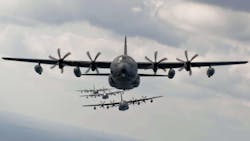Sierra Nevada moves to low-rate initial production on secure networking system for Special Forces planes
ROBINS AIR FORCE BASE, Ga. – U.S. Air Force avionics experts are asking Sierra Nevada Corp. in Sparks, Nev., to enable a Special Forces version of the Lockheed Martin C-130J four-engine turboprop aircraft to send and transmit secure mission-critical data.
Officials of the Air Force Life Cycle Management Center at Robins Air Force Base, Ga., announced a $29.8 million two-year order to Sierra Nevada last week for the MC-130J Airborne Mission Networking (AbMN) low-rate initial production (LRIP).
The AbMN enables aircrew and mission personnel aboard MC-130J aircraft to send and receive mission-critical data to and from tactical and operational nodes in the battlespace. This order is for production kits, spare parts, and weapon system trainer support.
LRIP describes production of a system in limited quantity to provide articles for operational test and evaluation. This is to establish an initial production base, and to permit an orderly increase in production rate that leads to full-rate production.
AbMN capabilities include secure line-of-sight and beyond-line-of-sight voice and data communications, friendly force identification, mission tracking, threat identification, full-motion video, collaboration, chat, email, and data links.
AbMN enables Special Operations Forces (SOF) to streamline command and control, improve situational awareness, and reduce operational risk through real time exchange of digital information among aircraft, SOF components, and other tactical and operational nodes.
The special operations MC-130J Commando II aircraft flies clandestine, or low-visibility single or multiship low-level air refueling missions for special operations helicopters and tiltrotor aircraft.
The MC-130J also performs infiltration, exfiltration, and resupply of Special Forces by air or by land inside of politically sensitive or hostile territories.
The MC-130J primarily flies missions at night to reduce probability of visual acquisition and intercept by airborne threats. Its secondary mission includes the airdrop of leaflets.
On this order Sierra Nevada will do the work in Centennial, Colo., and should be finished by January 2023. For more information contact Sierra Nevada Corp. online at www.sncorp.com, or the Air Force Life Cycle Management Center-Robins at www.robins.af.mil/Units/AFLCMC.
About the Author
John Keller
Editor-in-Chief
John Keller is the Editor-in-Chief, Military & Aerospace Electronics Magazine--provides extensive coverage and analysis of enabling electronics and optoelectronic technologies in military, space and commercial aviation applications. John has been a member of the Military & Aerospace Electronics staff since 1989 and chief editor since 1995.
